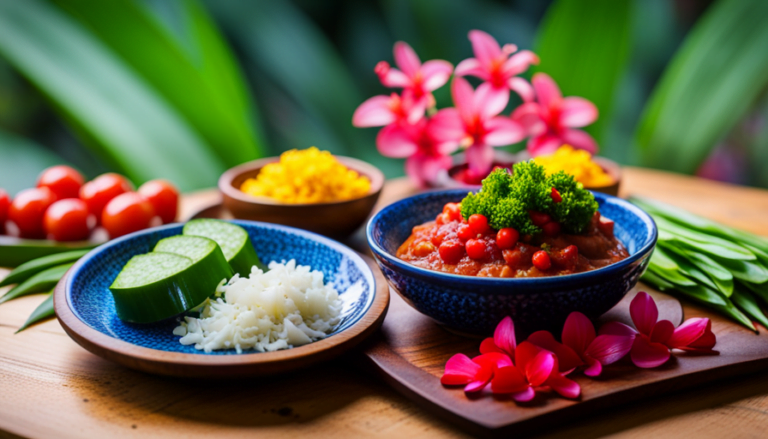Explore the Captivating Architectural Marvels of Oahu 🏰
You’re standing on an island, surrounded by the vast blue ocean. But don’t be fooled by the natural beauty of Oahu, for this island is also home to some of the most impressive architectural feats in the world.
From palaces to museums, from churches to city halls, Oahu boasts a rich cultural heritage that is reflected in its stunning architecture.
As you wander through the streets of Honolulu, you’ll find yourself transported back in time to a place where kings and queens once ruled.
The Iolani Palace stands tall and proud, a symbol of Hawaii’s monarchy and a testament to the island’s unique history. You’ll marvel at the intricate details of the palace’s architecture, from the grand staircase to the ornate throne room.
But the palace is more than just a beautiful building; it’s a living museum that provides a glimpse into Hawaii’s past and its struggle for independence. As you explore the palace, you’ll come to understand the deep connection between the people of Hawaii and their land.
Key Takeaways
- Oahu’s architectural attractions showcase the island’s unique history and culture, from traditional Hawaiian style to modernist and post-modernist designs.
- The architecture on Oahu is a blend of different cultural influences, creating unique and innovative styles that reflect the island’s rich heritage.
- Oahu’s buildings have witnessed political debates, cultural celebrations, and moments of tragedy and triumph, making them integral to the identity and soul of Hawaii.
- Understanding the historical and cultural significance of Oahu’s architectural attractions can offer a deeper appreciation for the island’s unique identity and the legacy of its people.
Iolani Palace
You can’t miss the opportunity to visit Iolani Palace, a stunning architectural gem that tells the story of Hawaii’s royal past. This beautiful palace was built in 1882 and served as the residence of Hawaii’s last reigning monarchs, King Kalakaua and Queen Liliuokalani.
The palace boasts a unique blend of Western and Hawaiian architectural styles, with ornate details and intricate woodwork that will leave you in awe. As you explore the palace, you’ll learn about Hawaii’s complex history and the struggles of its people during the time of colonization.
You’ll see the beautifully restored throne room, the private quarters of the royal family, and the stunningly intricate staircase that leads up to the second floor. Visiting Iolani Palace is a must-do for anyone interested in Hawaii’s royal past and the history of the islands.
Transitioning to the subsequent section about Bishop Museum, you’ll find another fascinating piece of Hawaii’s history waiting for you.
Bishop Museum
Explore the fascinating history of Hawaii at the Bishop Museum, where you’ll find a vast collection of artifacts and exhibits showcasing the culture and traditions of the islands.
The museum is home to over 24 million objects, from ancient Hawaiian artifacts to modern-day exhibits highlighting the impact of colonization on the islands.
As you wander through the vast halls, you’ll discover the rich history of Hawaii and its people, from the mythology surrounding the islands’ creation to the arrival of Captain Cook and the eventual overthrow of the Hawaiian monarchy.
One of the most impressive exhibits in the Bishop Museum is the Hawaiian Hall, which features three floors of artifacts, including ancient Hawaiian weapons, tools, and clothing.
The hall also includes interactive exhibits, such as a traditional Hawaiian canoe and a replica of a Hawaiian village, allowing you to immerse yourself in the culture and history of Hawaii.
After exploring the museum, head to the nearby Aloha Tower, where you can enjoy stunning views of the harbor and city skyline.
Aloha Tower
When you visit Aloha Tower, you’ll be stepping into a piece of history and significance.
This iconic tower was built in 1926 and served as a beacon for incoming ships until 1970.
The architecture and design of the tower is a beautiful blend of Hawaiian and Art Deco styles, making it a unique and striking sight.
As you ascend to the observation deck, you’ll be treated to breathtaking views of the harbor and city.
The marketplace at the base of the tower offers a variety of shops and restaurants for you to explore.
History and Significance
Take a step back in time and discover the rich history and cultural significance behind Oahu’s architectural landmarks. When it comes to the Aloha Tower, this towering structure has been an iconic symbol of Hawaii’s maritime history since its opening in 1926. Designed by Arthur Reynolds, the tower once served as a lighthouse and the tallest building in Hawaii, standing at 184 feet tall. Its clock, installed in 1927, was also the largest in the territory at the time.
The Aloha Tower was more than just a lighthouse and a clock tower. It served as a welcoming beacon to ships arriving at Honolulu Harbor, greeting visitors with its stunning Spanish-Moorish architecture and beautiful murals that showcased Hawaii’s rich cultural heritage. Today, the Aloha Tower Marketplace is a bustling retail and entertainment center, but the tower itself remains a historical landmark and a reminder of the island’s past. Its significance in Hawaii’s history makes it a must-see attraction for visitors to Oahu who are interested in the island’s architectural heritage.
Moving on to the next section about ‘architecture and design’, you’ll see how Oahu’s architectural attractions have evolved over time, from the traditional Hawaiian style to modernist and post-modernist designs.
Architecture and Design
As you delve into the topic of architecture and design, you’ll discover a world of creativity and innovation that will inspire and awe you. Oahu is home to some of the most unique architectural attractions that showcase the island’s rich cultural heritage and modern designs.
From the iconic Iolani Palace, which was once the residence of Hawaiian royalty, to the sleek and modern Honolulu Museum of Art, these structures offer a glimpse into the island’s past and present. One of the most notable architectural attractions on Oahu is the USS Arizona Memorial, which honors the lives lost during the attack on Pearl Harbor. The striking design of the memorial, which features a white structure that spans over the sunken battleship, is a testament to the resilience and courage of the American people.
Another must-see attraction is the Hawaii State Capitol, which was designed by renowned architect John Carl Warnecke. The distinct design of the building, which features a reflecting pool and a unique cone-shaped structure, is a nod to the island’s volcanic origins.
As you explore the architecture and design of Oahu, you’ll gain a deeper appreciation for the island’s beauty and history. Now, let’s move on to the next section and explore the observation deck and marketplace.
Observation Deck and Marketplace
You’ll love the stunning views and unique shopping experience at the observation deck and marketplace, where you can browse local crafts and souvenirs while taking in the breathtaking scenery.
Located on the 10th floor of the Ala Moana Center, this observation deck offers the best panoramic views of Honolulu and the surrounding areas. You can see the famous Waikiki Beach, Diamond Head, and even the Pearl Harbor Memorial from this vantage point.
Aside from the stunning view, the observation deck is also home to a marketplace where you can buy souvenirs, clothing, and local crafts. The marketplace is a unique shopping experience that offers a taste of Hawaiian culture. You can find handmade jewelry, locally made clothing, and other unique items that make great gifts for friends and family back home.
With the observation deck and marketplace, you can enjoy both sightseeing and shopping all in one location.
Now, let’s move on to the next attraction, the historic Kawaiahao Church.
Kawaiahao Church
As you approach the Kawaiahao Church, you’ll notice the church’s rich history and significance in the community.
The architecture and design of the church are a testament to the ingenuity and craftsmanship of the indigenous Hawaiian people.
The cultural and spiritual importance of the church cannot be overstated. It has served as a gathering place for worship, community events, and as a symbol of Hawaiian pride and resilience.
History and Significance
Explore the rich history and cultural significance of Oahu’s architectural attractions, and you’ll understand why they are such important landmarks in Hawaii’s past. One such attraction is the Kawaiahao Church, which has played a significant role in the Hawaiian Kingdom’s history. Built in 1842, the church served as the royal chapel for the ruling monarchs of the time. The church’s coral block exterior and grand size made it an impressive sight, especially given the limited construction materials available at the time.
But the Kawaiahao Church’s significance goes beyond just its grandeur. It was a symbol of the Hawaiian Kingdom’s struggle to maintain its independence in the face of increasing western influence. The church was built as a way to show the world that Hawaiians were capable of building impressive structures on their own, without the help of foreign powers. Today, the Kawaiahao Church stands as a reminder of Hawaii’s rich history and cultural identity, and serves as a testament to the strength and resilience of the Hawaiian people. As you delve deeper into Oahu’s architectural attractions, you’ll discover how each building played a unique role in shaping Hawaii’s past and present.
Moving on to the next subtopic about architecture and design, you’ll see how these attractions reflect the evolving styles and influences of the time.
Architecture and Design
Immerse yourself in the rich history and cultural identity of Hawaii by experiencing the unique architectural styles and designs of the past. Oahu is a treasure trove of architectural attractions that showcase the island’s diverse heritage and the influences that have shaped it over time.
Here are some examples of what you can expect to see:
- Hawaiian Architecture: Traditional Hawaiian architecture is characterized by its use of natural materials such as wood, thatch, and lava rock. The structures are designed to blend in with the natural environment and reflect the cultural values of harmony and balance. Some of the best examples of Hawaiian architecture on Oahu can be found at the Bishop Museum, Iolani Palace, and the Queen Emma Summer Palace.
- Plantation Architecture: During the plantation era, Oahu saw an influx of immigrants from different parts of the world, and their architectural influences can still be seen today. Plantation-style homes are characterized by their steep roofs, wide verandas, and ornate details. You can explore this style at the Waialua Sugar Mill and the Dillingham Ranch.
- Mid-Century Modern Architecture: Oahu was also home to some of the most significant mid-century modern architects, such as Vladimir Ossipoff and Alfred Preis. Buildings like the IBM Building and the Hawaii State Capitol showcase the clean lines, functional spaces, and use of technology that defined this period of architectural design.
By exploring these architectural attractions, you can gain a deeper appreciation for the cultural and historical significance of the buildings and the people who designed and built them.
As you move on to the next section about the cultural and spiritual importance, you’ll begin to understand how these structures are more than just pretty buildings – they’re integral to the identity and soul of Hawaii.
Cultural and Spiritual Importance
You’ll feel a deep connection to Hawaii’s rich cultural and spiritual heritage as you discover the significance of its architectural masterpieces. The state’s architecture is steeped in tradition and symbolism, with roots tracing back to the early Polynesian settlers who first arrived on the islands.
Many of the buildings on Oahu, from the ancient heiaus to the more modern structures, have been designed and constructed with a deep respect for the land, the sea, and the spirits that inhabit them. As you explore the island’s architectural attractions, you’ll come across many examples of this reverence for the culture and spirituality of the Hawaiian people.
One such example is the Honolulu City Hall, which was designed to reflect the natural beauty and cultural heritage of the islands. Its unique architecture, with its sweeping curves and open spaces, was inspired by the traditional Hawaiian hale, or house, and serves as a reminder of the importance of preserving the past while embracing the future.
Honolulu City Hall
As you turn your attention towards Honolulu City Hall, you’ll find yourself immersed in a discussion about its rich history and significance.
With its construction dating back to 1928, the building has stood as an emblem of resilience and cultural heritage for the people of Hawaii.
Upon further examination, you’ll notice the intricate architecture and design elements that make it a true masterpiece, with its blend of Spanish and Italian Renaissance styles.
Finally, no discussion about this architectural marvel is complete without mentioning the public art and exhibits that adorn its walls, showcasing the rich cultural tapestry of Honolulu.
History and Significance
Though it’s tempting to breeze past the history and significance of Oahu’s architectural attractions, you’ll be missing out on a fascinating glimpse into the island’s past.
Honolulu City Hall, for example, was built in 1928 and is a prime example of Beaux-Arts architecture, a style that dominated government buildings in the early 20th century. The building’s design, with its columns and grand entrance, was meant to convey a sense of authority and power, reflecting the confidence and optimism of the time.
But the significance of Honolulu City Hall goes beyond its impressive architecture. The building has played a key role in shaping the island’s history, serving as a hub for government activity and community events for nearly a century. Its halls have witnessed political debates, cultural celebrations, and moments of tragedy and triumph, making it a valuable piece of Oahu’s cultural heritage.
As you explore Oahu’s architectural attractions, keep in mind the rich history and significance behind each building you encounter.
Now, let’s delve into the intricate details of architecture and design, and discover the unique features that make Oahu’s buildings so impressive.
Architecture and Design
Get ready to explore the intricate details of the impressive architecture and design found throughout the island of Oahu. From traditional Hawaiian influences to modern and contemporary designs, Oahu is home to a variety of architectural styles that capture the island’s unique history and culture.
One of the most notable examples is the Iolani Palace, which was built in 1882 and served as the royal residence for the last two monarchs of Hawaii. The palace features intricate woodwork, ornate decorations, and innovative technologies for its time, such as indoor plumbing and electric lighting.
Another architectural gem on Oahu is the Hawaii State Capitol, designed by renowned architect John Carl Warnecke. The building’s unique design features a central rotunda and open-air lanais, providing stunning views of the surrounding area. The Capitol also houses several significant artworks, including a bronze statue of King Kamehameha I, the founder of the Hawaiian kingdom.
Overall, Oahu’s architecture and design offer a glimpse into the island’s rich history and cultural heritage, making it a must-see destination for architecture enthusiasts and history buffs alike.
As you continue your exploration of Oahu’s architectural attractions, be sure to also check out the island’s impressive public art and exhibits. These showcase the works of local artists and provide insight into the island’s contemporary art scene. From the Honolulu Museum of Art to the Kaka’ako Murals, there are plenty of opportunities to experience the beauty and creativity of Oahu’s art and design.
So, get ready to immerse yourself in the island’s vibrant culture and explore the many wonders it has to offer.
Public Art and Exhibits
You’ll love exploring the vibrant public art and exhibits on display throughout the island, showcasing the creativity and talent of local artists.
The Honolulu Museum of Art features over 50,000 works from all over the world, including Hawaii, Asia, and Europe. The museum’s collection includes paintings, sculptures, and photographs, as well as textiles, ceramics, and glassware. You can also visit the museum’s outdoor sculpture garden, which features works by both local and international artists.
Another great destination for public art is the Bishop Museum. Here, you can explore exhibits that showcase the history, culture, and natural wonders of Hawaii and the Pacific. The museum’s outdoor area, meanwhile, features a collection of large-scale sculptures, including a giant bronze statue of King Kamehameha I.
Whether you’re interested in contemporary art or traditional Hawaiian crafts, you’re sure to find something to inspire and delight you on Oahu. With so much to see and experience, you’ll want to keep exploring the island’s architectural and cultural landmarks, starting with the Hawaii State Capitol.
Hawaii State Capitol
If you’re interested in the history and significance of Hawaii’s government, the Hawaii State Capitol building is a must-visit. The unique architecture and design of the building make it a notable landmark in Honolulu. The legislative process and governance that take place within its walls are key to understanding the state’s political landscape.
As you explore the building’s halls and chambers, you’ll gain a deeper appreciation for the role it plays in shaping Hawaii’s future.
History and Significance
As you explore the Hawaii State Capitol, you’ll discover the history and significance behind this iconic structure.
The building was designed by renowned architect John Carl Warnecke and completed in 1969 as a symbol of Hawaii’s newly-acquired statehood. Its unique design features a central rotunda and two legislative chambers, representing Hawaii’s rich cultural heritage and political structure.
Aside from its architectural significance, the Hawaii State Capitol also played a pivotal role in the state’s history. It was the site of many significant events, including the signing of the Hawaii State Constitution and the funeral of Senator Daniel Inouye.
By visiting this important landmark, you’ll gain a deeper appreciation for the role of architecture in shaping Hawaii’s cultural identity.
Moving on to the next section, let’s take a closer look at the building’s innovative architecture and design.
Architecture and Design
Take a moment to appreciate the innovative design of the Hawaii State Capitol, which resembles a majestic bird in flight, soaring above the surrounding landscape like an eagle. The building was designed by architect John Carl Warnecke, who was inspired by the natural beauty of the Hawaiian Islands. The Capitol’s unique shape and use of materials, such as pre-cast concrete and lava rock, reflect the cultural and geological history of the area.
To further explore the architectural wonders of Oahu, take a trip to the Honolulu Museum of Art, which boasts an impressive collection of Asian, European, and American art, as well as a stunningly designed building. The museum’s main building, built in 1927, features a blend of neoclassical and Hawaiian architectural styles, with a grand entrance staircase and open-air courtyards. Additionally, the museum’s Spalding House location, which was originally built as a private residence in 1925, showcases modernist architecture and offers breathtaking views of Diamond Head.
As you delve deeper into the beauty and design of Oahu’s architectural attractions, it’s important to also understand the legislative process and governance that shape these structures.
Legislative Process and Governance
Now that you’ve learned about the importance of architecture and design in shaping Oahu’s skyline, it’s time to delve into the legislative process and governance that governs the construction and preservation of these structures.
The state of Hawaii has established various laws and regulations to ensure that buildings meet safety standards and are in line with the state’s environmental and cultural values. This process involves a range of stakeholders, including architects, engineers, contractors, and government officials who work collaboratively to ensure that buildings are not only structurally sound but also aesthetically pleasing and harmonious with their surroundings.
In addition to the regulatory framework, governance also plays a crucial role in shaping Oahu’s architectural landscape. This involves the decision-making processes of local government bodies, such as city councils and planning commissions, who have the power to approve or reject building proposals. These decisions are often influenced by a range of factors, including public opinion, economic considerations, and the desire to preserve Oahu’s unique cultural heritage.
Understanding the complex interplay between regulation and governance is essential for appreciating the significance of Oahu’s architectural attractions and the challenges faced by those who seek to create them.
As you move on to the next section, you’ll learn about one of Oahu’s most breathtaking architectural attractions, the Foster Botanical Garden. This magnificent garden is home to thousands of plant species from around the world and is a testament to the beauty and diversity of Oahu’s natural environment.
Foster Botanical Garden
As you step into the Foster Botanical Garden, you’ll be immersed in a world of history and significance that dates back to the mid-19th century. The garden’s architecture and design are a testament to its rich cultural heritage, with influences from Hawaiian, Chinese, and Japanese cultures.
Beyond its impressive beauty, the garden is also home to a diverse range of plant collections, and ongoing conservation efforts that aim to preserve the unique flora of Hawaii.
History and Significance
The history and significance of Oahu’s architectural attractions is fascinating, with each building telling a unique story. From ancient Hawaiian heiau temples to the modernist design of the Hawaii State Capitol building, Oahu’s architecture is a testament to the island’s rich cultural heritage and its ever-evolving identity.
Here are some noteworthy aspects of Oahu’s architectural history:
- The iconic Iolani Palace was built in 1882 and served as the residence of Hawaii’s last reigning monarchs, King Kalakaua and Queen Liliuokalani.
- The USS Arizona Memorial, designed by architect Alfred Preis, stands as a powerful tribute to the lives lost during the attack on Pearl Harbor.
- The Royal Hawaiian Hotel, also known as the ‘Pink Palace of the Pacific,’ was built in 1927 and is now a luxurious resort that has hosted numerous celebrities and dignitaries over the years.
- The historic Chinatown district of Honolulu is home to some of Oahu’s oldest and most culturally significant buildings, including the Kuan Yin Temple and the historic Hawaii Theatre.
- The Bishop Museum, founded in 1889, is home to an impressive collection of Hawaiian artifacts and serves as a hub for cultural education and preservation.
As you explore Oahu’s architectural attractions, it’s important to consider not only the aesthetic value of each building but also the historical and cultural significance that they represent. Understanding the stories behind these structures can offer a deeper appreciation for the island’s unique identity and the legacy of its people.
Moving forward, let’s delve into the fascinating world of architecture and design on Oahu.
Architecture and Design
Walking through the streets of Honolulu, you’ll notice a vibrant mix of architectural styles and designs that reflect the island’s diverse cultural influences. From the ornate details of the Iolani Palace, a symbol of the Hawaiian monarchy’s power and prestige, to the sleek lines of the Hawaii State Capitol building, a modernist masterpiece by renowned architect John Carl Warnecke, the architecture of Oahu is a testament to the island’s rich history and dynamic present.
One of the most intriguing aspects of Oahu’s architecture is the way in which different cultural influences have blended together to create unique and innovative styles. The table below highlights some of the key design elements and cultural influences that can be seen in Oahu’s architectural landscape. Whether you’re interested in exploring historic landmarks or admiring contemporary works of art, the architecture of Oahu is sure to captivate and inspire you. As you continue your journey through the island’s diverse cultural attractions, you’ll discover even more ways in which Oahu’s natural beauty and cultural heritage are being preserved and celebrated.
Plant Collections and Conservation Efforts
You’ll be amazed by the extensive plant collections and conservation efforts that are being made to protect the natural beauty of the island. The Lyon Arboretum is a must-visit destination, as it plays a crucial role in preserving and studying the native flora of Hawaii. With over 5,000 species of plants, including rare and endangered species, the arboretum is a treasure trove of botanical wonders.
The staff and volunteers have curated a diverse range of gardens, each with its unique theme and purpose. From the palm garden to the herb garden, there’s something for everyone. Additionally, the arboretum conducts research on plant propagation and conservation, ensuring that future generations can benefit from the beauty and biodiversity of Hawaii.
Apart from the Lyon Arboretum, there are many other places where you can appreciate the flora of Oahu. The Foster Botanical Garden is another excellent destination to explore. The garden features a vast collection of tropical plants from around the world, including some of the largest and oldest trees on the island.
The garden is also home to the conservatory, which houses an impressive collection of orchids and carnivorous plants. The garden’s conservation efforts focus on preserving rare and endangered species, such as the Hawaiian tree fern and the Mao hau hele, a native shrub with medicinal properties.
By visiting these gardens and learning about their conservation efforts, you’ll gain a deeper appreciation for the importance of protecting the natural beauty of Oahu.
Conclusion
So, you’ve explored some of the most amazing architectural attractions that Oahu has to offer. You’ve walked through the halls of Iolani Palace, learned about Hawaiian history at the Bishop Museum, marveled at the views from Aloha Tower, and admired the beauty of Kawaiahao Church.
You’ve also seen the impressive architecture of Honolulu City Hall and the Hawaii State Capitol, and wandered through the lush gardens of Foster Botanical Garden.
But did you know that Oahu has the highest concentration of registered historic landmarks in the entire United States? With over 33,000 buildings and sites listed on the National Register of Historic Places, Oahu offers a unique blend of history, culture, and architecture that cannot be found anywhere else.
From ancient Hawaiian temples and royal palaces to modern skyscrapers and government buildings, Oahu’s architectural treasures tell the story of the island’s rich and diverse past.
So, next time you’re in Oahu, take some time to explore its architectural attractions. You never know what hidden gems you might discover and what fascinating stories they might have to tell. Whether you’re a history buff, an architecture enthusiast, or just someone looking for a unique and unforgettable experience, Oahu has something for everyone.







